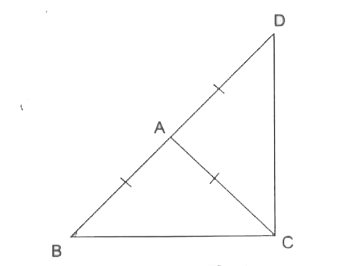ΔABC,AB=AC and BA is produced to D such that AC = AD. Then the ∠BCD is
100∘
60∘
80∘
90∘
The correct Answer is:D
To solve the problem, we need to analyze the given triangle ABC where AB = AC and the line BA is extended to point D such that AC = AD. We need to find the measure of angle BCD.
1. Identify the Triangle and Given Information:
- We have triangle ABC where AB = AC.
- Point D is on the extension of line BA such that AC = AD.
2. Label the Angles:
- Let angle ABC = x.
- Since AB = AC, by the properties of isosceles triangles, angle ACB = x as well.
3. Determine Angle A:
- The sum of angles in triangle ABC is 180 degrees:
Angle A+Angle ABC+Angle ACB=180
- Thus, we have:
Angle A+x+x=180
- This simplifies to:
Angle A+2x=180
- Therefore:
Angle A=180−2x
4. Analyze Triangle ACD:
- In triangle ACD, we know that AC = AD (given).
- Therefore, triangle ACD is also isosceles, which means:
Angle ADC=Angle ACD=y
- The sum of angles in triangle ACD is also 180 degrees:
Angle A+Angle ADC+Angle ACD=180
- This gives us:
(180−2x)+y+y=180
- Simplifying this, we find:
180−2x+2y=180
- Thus:
2y=2x⇒y=x
5. Find Angle BCD:
- In triangle BCD, we can express the angles as follows:
Angle ABC+Angle BCD+Angle BDC=180
- We know that angle BDC is equal to angle ADC, which we found to be y. Thus:
x+Angle BCD+y=180
- Since y = x, we can substitute:
x+Angle BCD+x=180
- This simplifies to:
2x+Angle BCD=180
- Rearranging gives:
Angle BCD=180−2x
6. Substituting for Angle BCD:
- We already established that angle A = 180 - 2x. Therefore:
Angle BCD=90
Conclusion:
The measure of angle BCD is 90 degrees.
- We have triangle ABC where AB = AC.
- Point D is on the extension of line BA such that AC = AD.
- Let angle ABC = x.
- Since AB = AC, by the properties of isosceles triangles, angle ACB = x as well.
- The sum of angles in triangle ABC is 180 degrees:
Angle A+Angle ABC+Angle ACB=180
- Thus, we have:
Angle A+x+x=180
- This simplifies to:
Angle A+2x=180
- Therefore:
Angle A=180−2x
- In triangle ACD, we know that AC = AD (given).
- Therefore, triangle ACD is also isosceles, which means:
Angle ADC=Angle ACD=y
- The sum of angles in triangle ACD is also 180 degrees:
Angle A+Angle ADC+Angle ACD=180
- This gives us:
(180−2x)+y+y=180
- Simplifying this, we find:
180−2x+2y=180
- Thus:
2y=2x⇒y=x
- In triangle BCD, we can express the angles as follows:
Angle ABC+Angle BCD+Angle BDC=180
- We know that angle BDC is equal to angle ADC, which we found to be y. Thus:
x+Angle BCD+y=180
- Since y = x, we can substitute:
x+Angle BCD+x=180
- This simplifies to:
2x+Angle BCD=180
- Rearranging gives:
Angle BCD=180−2x
- We already established that angle A = 180 - 2x. Therefore:
Angle BCD=90
The measure of angle BCD is 90 degrees.
Similar Questions
△ABC is an isosceles triangle in which AB= AC. Side BA is produced to D such that AD = AB. Show that ∠BCD is a right angle.

View SolutiontriangleABC An isosceles triangle. Is AB = AC. BA is multiplied by D to AD = AB (see Figure). angleBCD Show that a right angle.
View SolutionΔABC is an isosceles triangle with AB=AC, side BA is produced to D such that AB=AD. Prove that ∠BCD is a right angle.
View SolutionIn a triangle ABC, AB=AC. BA is produced to D in such a manner that AC=AD. The circular measure of ∠BCD is
View SolutionIn ΔABC, AB = AC and side BA is produced to D such that AB = AD then ∠BCD is equal to :
View SolutionABC is an isosceles triangle with AB = AC. Side BA is produced to D such that AB=AD. Find the ∠BCD:
View SolutionABC is an isosceles triangle with AB = AC. Side BA is produced to D such that AB=AD. Find the ∠BCD:
View Solution
